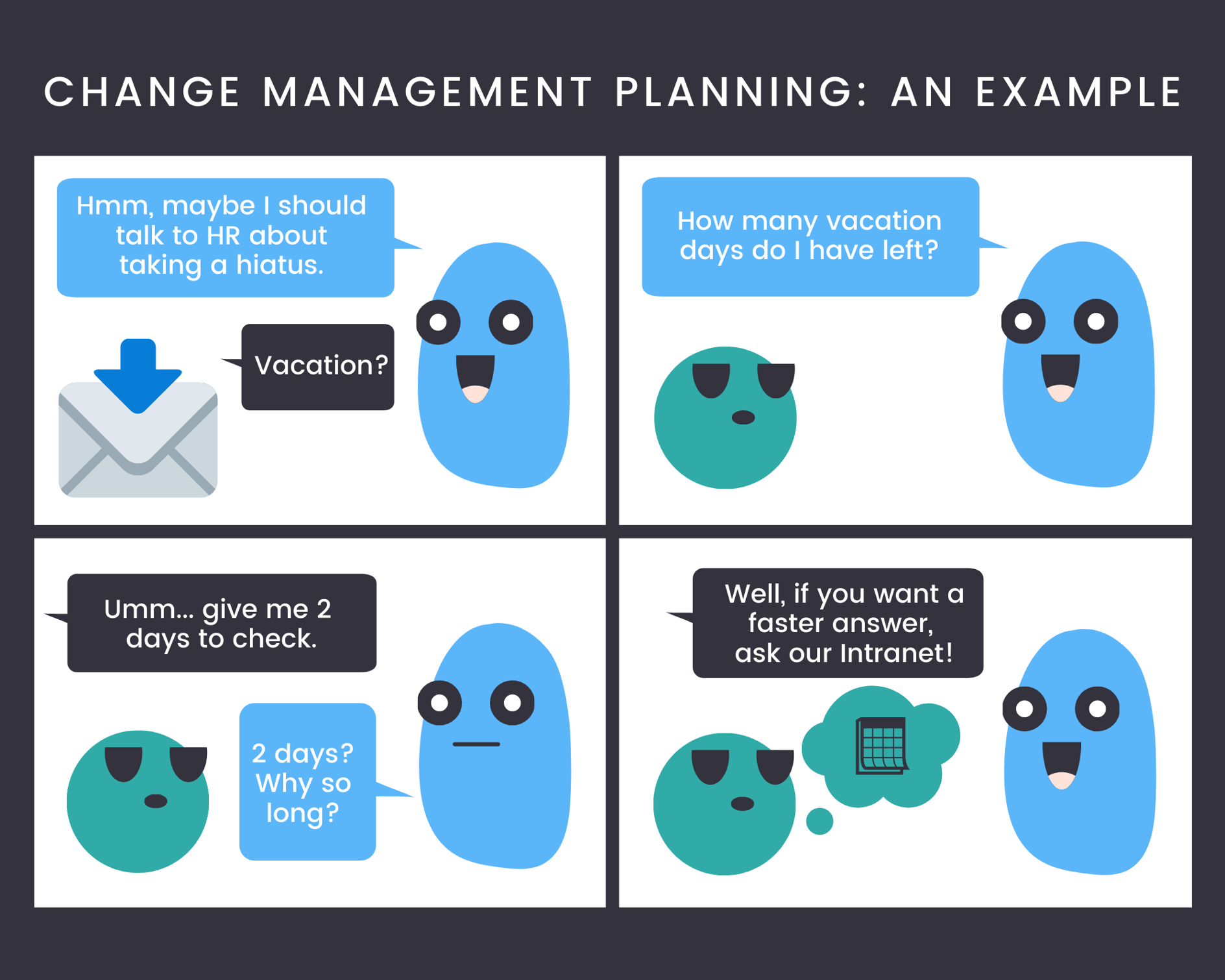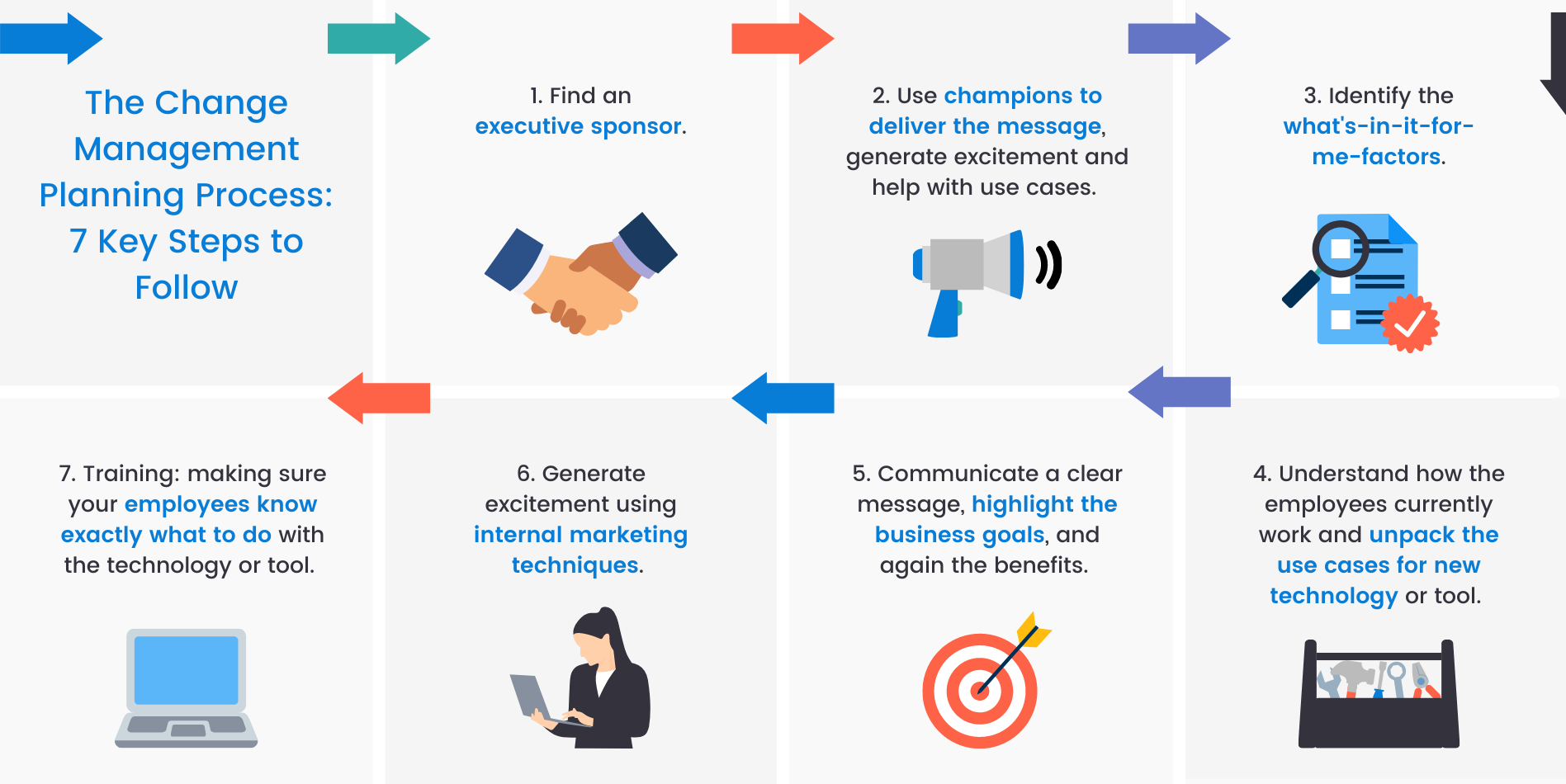Change management planning is one of those things that’s not going away any time soon – like it or not, or whether you agree with it or not, if you need to make significant changes in your organization, you need to have solid change management planning in place before you do. In fact, the way that you handle change management for your employees determines how successful the change is.
So, let’s talk about change management planning. Technology has advanced significantly in the past decade, and, while that change has been all for the better for some aspects, other aspects, like how organizations plan for change, have suffered greatly. So, in this blog, we’re going to look at change management planning from back then, and compare it to the journey now, while also showing you why proper change management planning is so important.
Let’s dive right in.
Change Management Planning: Where We’ve Come From
Before the Software-as-a-Solution (SaaS) era, getting a new tool was a lengthy process that took months, if not years to implement. It was a huge undertaking! Deciding to buy the tool, determining how you were going to roll it out, satisfying various hardware and software requirements, purchasing the proper equipment, implementing it in your organization then testing and fixing bugs, investing in end user training and then finally rolling the new tool out to everyone – what an ordeal! Not to mention that going through that long process required multiple staff involved, and extensive efforts – it’s no wonder that you had to factor in so many costs to implement that tool.
But there was a huge benefit to this amount of hassle to implement something – since it was such a high price tag to get exactly what they wanted, organizations took much longer and were much more deliberate in planning out their long-term goals and objectives when it came to this new tool they were purchasing. In addition, since it took so long (intentionally or unintentionally) to buy and implement, those organizations were able to give their end users plenty of time to get used to the idea of this change, as well as the support they needed to transition to the new tool once they had gone ahead with the implementation.
What Does This Mean? An Example
To illustrate what we’re talking about, let’s take a very common issue in many organizations: an employee wants to obtain their current vacation balance – how many vacation days do they have left for that fiscal year?
Let’s set the scene a little bit here. Arthur Doyle of ABC Company has been sent an email about a last-minute vacation deal to Cancun, Mexico, and he and his wife decide, why not? They’ve both been working hard. They need some time away. But Arthur doesn’t remember how many vacation days he has left. So, he sends an email to his HR representative and asks them that exact question.
Unfortunately, the organization doesn’t have an automated system in place that will easily provide this information – that HR representative has to go through all of Arthur’s previous vacation requests, match them up with her approved vacations, and deduct how much time there is remaining. Since the HR representative also has other duties, it takes two days to get back to Arthur with this information, and by then, the sale has already ended. Arthur and his wife have missed out on the deal.
Meanwhile, the CFO of ABC Company doesn’t like how much time it takes their HR department to handle requests like this – it takes away from the more pressing issues that the HR department needs to handle. So, he recommends to the CEO of the company that they should look into implementing a company intranet that will assist in automating this task. If they can find the right intranet, they’ll have the ability to give their employees a way for them to see how much vacation time they have left, and employees will even be able to submit vacation requests right from the link provided.
Related: An Effective Change Management Process in 4 Easy Steps
Stay up to date with ProServeIT! 📨
Our monthly newsletter has all that as well as insightful information on relevant technology, webinars and workshops. Make sure to sign up now for your dose of tech knowledge delivered straight to your inbox!
So, ABC Company begins researching intranet options, including pricing for hardware, what software they’d need to run the intranet, the budget that would be involved, and, more importantly, what else this intranet would be able to do for the organization. At the next quarterly board meeting, the executive team provides the board with the numbers they’ve come up with. The board approves the savings in HR’s time, and ABC company decides to go ahead with the implementation.
The executive sends out an email to all staff about the coming change. Arthur, who’s still ticked about losing the last-minute deal, is happy about the fact that he’ll no longer miss out on great offers. He talks to his co-workers about how great this change will be for the organization. They, in turn, get excited about it.
By the time ABC Company rolls out the intranet six months later, everyone is excited about the possibilities that will open up to them! In this case, not having an instant fix to the problem worked out to their advantage – they were able to give everyone plenty of notice that the change was going to occur, they were able to entice employees to champion the change, and they provided real proof of the benefits that this new intranet would give the employees.

Change Management Planning: How Software-as-a-Solution Has Changed the Game
With the introduction of Software-as-a-Solution (SaaS) applications and other various Cloud-based technology, most of the tools that organizations are implementing nowadays are ready-to-use, easy to spin up and implement, and don’t require nearly the same amount of planning that they used to. In many ways, SaaS options provide your organization with a number of key benefits. For instance, monthly subscriptions provide organizations with easy payment options with no huge upfront costs required, and SaaS products allow organizations easy access to a number of great tools that will help them make work easier and get things done faster.
However, the ease of implementation does have one massive disadvantage: it doesn’t require the same amount of planning. Which means that having an organizational change management plan is even more important now than it ever used to be. Not only to prepare your employees for the change that’s about to take place, but also to plan out exactly which tools you’re going to implement and how they’re going to work together within your environment. Plus, some of these tools are quite similar – if you were to implement a tool in your organization that does something similar to another tool that you already have, do your employees know when to use what?
By introducing new tools (and even new features within a previously established tool) organizations often overlook the change management process and how this change will affect their end users. There is an assumption that, because it’s easier for organizations to implement, it’ll be easier for employees to adapt to it, but that’s not the case. Without properly preparing your end users, you’re forcing them into “resistance mode” – they haven’t been told how this new tool or new feature is going to make their lives easier, they see it as more of a hassle than anything else, and they don’t want to take the time to learn something new.
Check out the short video below to see 4 steps to an effective change management process:
The Change Management Planning Process – 7 Key Steps to Follow

So, in order to get the most of your investment and aid in a smoother transition to the new technology you’re implementing, let’s look at 7 key steps that we think your change management process should be following:
1.👨🏽💼 Find an executive sponsor
Research shows that sponsorship from the top (C-Level) down is the most important success factor in implementing a new technology or tool. If you want to make your employees feel better about the change, have your CEO or the leadership team championing this initiative and actually using the new technology or tool.
2.📣 Use champions to deliver the message, generate excitement and help with use cases
Just like Jane in our example above, change management champions can help your employees to get excited about what the changes to the organization will mean for them.
3.🔎 Identify the what's-in-it-for-me factors
Employees, as mentioned, need to understand what the new technology or tool is going to do for them. When you take the time to show them how this is going to make their life easier, they’re much more likely to embrace the new technology and, in turn, increase your ROI.
4.🧰 Understand how the employees currently work and unpack the use cases for the new technology or tool
Before you implement something new, understand how your employees are currently doing their jobs, and determine what pain points they’re experiencing. This, along with the previous step, will help you to ensure that you’re implementing something that’s going to make them work smarter, not harder.
5.🎯 Communicate a clear message, highlight the business goals, and again the benefits
Let your employees know why you’re implementing this new technology or tool in a clear, concise way (and make sure that you’re doing this well before the implementation!).
6.👩🏼💻 Generate excitement using internal marketing techniques
Show people the new tool or technology in action, create one-pagers and graphics that will help employees understand the benefits of the new technology or tool, let people know when they can expect changes to take place. Internal marketing techniques like these will help you get everyone on the same page long before the new tool or technology is implemented.
7. 💻 Training: making sure your employees know exactly what to do with the technology or tool
Host training, lunch and learns, or town hall meetings where you walk through the new tool and give your employees the proper training that they need to be successful in using it.
Let ProServeIT Assist You With Your Change Management Planning Process!
At ProServeIT, we place a huge emphasis on organizational change management. Whenever we introduce new technology into an organization, we do our utmost to ensure that they’re getting the most from their investment – from planning, to customized communication, to training, to launch, and everything in between.
Whether it’s end-user training, success management programs, internal or external communications plans, or other new technology adoption tools and techniques, ProServeIT is ready and able to assist with your IT change management needs. We’ll:
- ☑️ Work with you and your key stakeholders to understand your business goals,
- Analyze your current processes and technologies that you have in place to determine how new technology might fit in, and
- ☑️ Recommend how to best utilize those technologies, suggest new tools to improve your organization’s efficiencies, and follow up with necessary training and onboarding to help you boost your end-user adoption.
Ready to get started? Connect with us today and let us show you how we can help your organization get the maximum ROI on your newest technology investment using proper change management planning!
 Teams Governance Workshop
Teams Governance Workshop
The Municipal Property Assessment Corporation (MPAC) provides a comprehensive database of information for more than 5 million properties in Ontario. Through a Teams Governance Workshop, they were able to understand how their employees could collaborate and share information more effectively utilizing Microsoft Teams.
The Workshop showed MPAC several ways that they could accelerate their digital transformation by aligning their business opportunities and challenges with the capabilities of Teams. Learn More about Teams Governance Workshop
Tags:
March 15, 2021
.png?width=3696&name=Change%20Management%20Offer%20Banner%20(1).png)